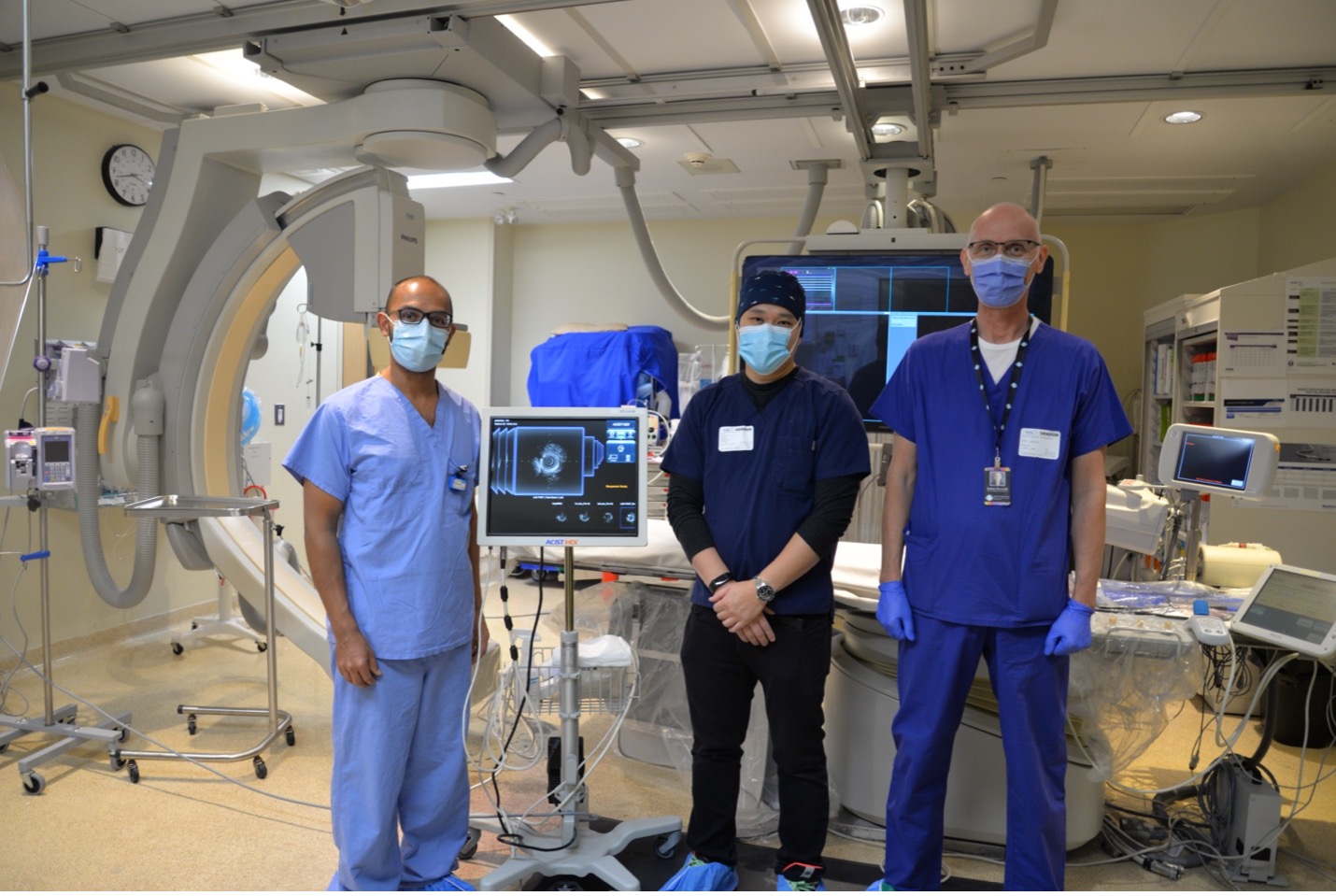Photo (left to right): Dr. Ram Vijayaraghavan, Medical Director, Cath Lab, SHN; Simon Wong, Clinical Specialist, BRACCO Imaging; and Stefano Serravalle, Business Manager Americas, ACIST
SHN first hospital in Canada to trial HDi ultrasound device for viewing coronary arteries
At the heart of Scarborough Health Network’s (SHN) regional cardiac centre, an expert team of cardiologists and nurses are performing life-changing procedures and using ground-breaking, leading technologies to diagnose and treat heart conditions and diseases.
Most recently, Dr. Ram Vijayaraghavan trialed an intravascular ultrasound (IVUS) device called HDi from ACIST and BRACCO Imaging. With this high-definition diagnostic imaging device, doctors are able to see sharper, clearer pictures of a patient’s blood vessels feeding the heart, allowing for improved cardiac procedures. Ultimately, HDi helps the care team to best visualize any coronary complications that can lead to major adverse cardiovascular events (MACE).
Approved for use by Health Canada in 2020, this was the first time a Canadian hospital has trialed this particular intravascular ultrasound technology, and it was demonstrated and used successfully in one of SHN’s three catherization labs at its regional cardiac centre.
“IVUS is available widely, but this particular HDi device has an easy-to-use interface with very, very high-quality images, and is the first to enable what we call High Definition (HD) IVUS,” said Dr. Vijayaraghavan.
IVUS is used in many complex scenarios, helping doctors like Dr. Vijayaraghavan treat patients. When used as part of a successful percutaneous coronary intervention (a procedure used to open clogged heart arteries), IVUS can be life-extending and life-changing with less heart attacks and less symptoms long-term. Patients travel to SHN from across the province, and some from across the country, to receive these types of diagnostics and treatments.
In cases where stents (tiny tubes that are implanted to open up narrowed arteries) are needed, the HDi device truly shines. “It can tell you exactly what size and length of stent the artery needs, and how best to prepare the artery for the stent,” says Dr. Vijayaraghavan. He noted that the size of the stent is critical. If it’s too big it can be dangerous, and if it’s too small it can fail over the long-term.
In addition, IVUS can be used to help doctors see entire artery walls and provide more information about plaque buildup. “Intravascular ultrasound is something used in about 10 to 20 per cent of cases to improve stents, and to get a really great result and to understand what is really going on in the artery better than in a regular angiography (another kind of heart imaging procedure),” explained Dr. Vijayaraghavan. “And the HDi device is particularly excellent for complex cases that require additional imaging information.”
“There are aspects of imaging with the HDi device that are really unique and special. It allows for the procedures to be done with very high accuracy and ability to interpret. Far more efficient than other forms of IVUS that are available right now,” he said.
The images feature better contrast for border detection and the device improves the balance of high-resolution images, giving doctors a deeper, more detailed look at their patient’s needs.
“The purpose of using the ultrasound, in this case, was to measure the artery so we could get the right size stent for the patient, and to understand the nature of the disease – whether it’s very calcified or not,” he said.
If the plaque is heavily calcified, a doctor may need to consider additional tools before opening the artery and implanting the stent.
As home to the designated cardiac centre for Scarborough, Durham and other areas across the Central East region of Ontario, SHN already offers the most comprehensive range of cardiac services to local and surrounding communities. This kind of state-of-the-art technology means SHN continues to lead in cardiac care, including in intracoronary imaging, across the province.
“Although, this device, has previously been available in the United States and Europe – it’s the first time it has come to Canada and I’m confident others will be interested in it,” Dr. Vijayaraghavan explained.
“We are committed to using different types of technologies and intravascular imaging; it speaks to our level of expertise and the desire for even better results for our patients.”

